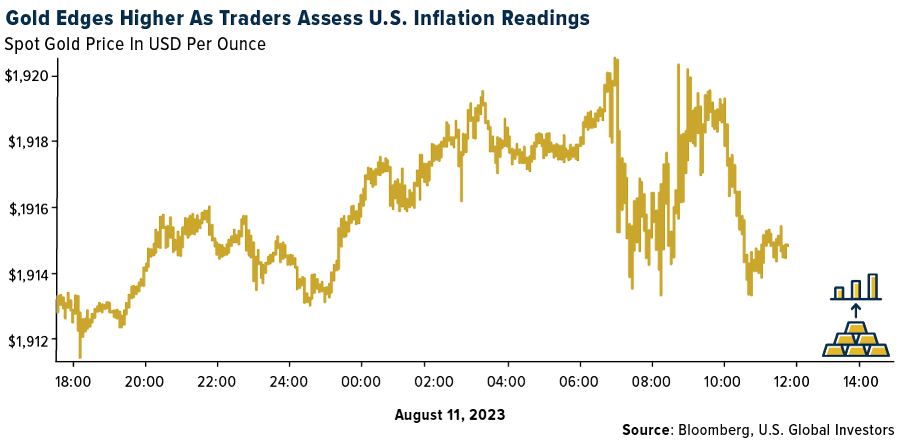Strengths
- The best performing precious metal for the week was palladium, up 2.72%, on what might be the beginning of a short squeeze. Palladium had fallen 24% since mid-May, up until a recent rally on news that speculators had taken their short palladium positions to the most bearish position on record going back to December 2009.
- China raised its gold reserves for a ninth straight month in July as central bank purchases continue to underpin prices of the precious metal. Bullion held by the People’s Bank of China (PBOC) rose by 740,000 troy ounces, the central bank said on Monday, which is equivalent to about 23 tons.
- For Alamos Gold, based on 44% higher reserves versus the 2017 study, total production is now expected to be 2.2 million ounces, up 46% versus 1.5 million ounces in the 2017 study. LOM AISC is now expected to be $814 per ounce, up 9% from $745 per ounce in the 2017 study.
- Franco-Nevada reported second quarter adjusted earnings of $0.95 per share, ahead of consensus of $0.89 per share. When compared to consensus, results were ahead in the precious metals segment. In the quarter, operations at Cobre Panama and Antapaccay successfully returned to full production, contributing strong deliveries to Franco-Nevada. Overall, for the quarter, Franco-Nevada reported gold-equivalent ounces (GEOs) of 168,515 ounces, ahead of consensus of 166,000 ounces.
Weaknesses
- The worst performing precious metal for the week was silver, down 4.14%, illustrating it’s near 3 to 1 leverage factor to the price move in gold this week. Gold had choppy daily price action with a bias to the downside until a slight gain on Friday. Impala Platinum's fiscal year 2023 gross refined production 6E declined 5% year-over-year to 2.92 million ounces and was ~2% below company-compiled consensus. The key miss was driven by IRS where volumes declined 16% year-over-year and came in 4% below consensus. Management highlighted 111,000 ounces of production was deferred due to power constraints, the delay to restart the refurbished Number 4 furnace, and cable theft at Impala Rustenburg.

- MAG Silver reported second quarter financial results with diluted EPS of $0.19 from attributable production of 2.32 million ounces silver that was pre-reported. Unit production costs were not reported, but aggregate production costs were $71.2 million (15% above consensus).
- Gatos reported second quarter 2023 EPS of -$0.05 compared to consensus of $0.05, resulting from both lower equity income pickup from the Los Gatos JV (driven by higher depreciation, depletion, amortization, and income tax expenses) and higher G&A costs at the corporate level (driven by an increase in one-time audit and consulting fees from the restatement of the financial statements).
Opportunities
- According to Scotia, Kinross’s focus for the next 12 months is on further de-risking key assets, which include some of the following: 1) delivering on the Tasiast 24,000 mill expansion to its sustained capacity by year-end, 2) delivering a PEA at Great Bear in 2024, including permitting the exploration decline, 3) de-risking the mine plan at Round Mountain, with construction of the decline in 2024 and study work at Gold Hill satellite.
- Greatland Gold would likely bid for full control of the Havieron gold-copper project in Western Australia if it goes up for sale following Newmont’s acquisition of
Newcrest, according to Managing Director Shaun Day. The Havieron and nearby Telfer gold mines and mill are likely to be among assets that Newmont will look to sell. - Silvercorp announced the planned acquisition of OreCorp Ltd. and its Nyanzaga Gold Project in Tanzania for A$242 million in cash and shares. This is the second acquisition announced by Silvercorp this year; in May, the company signed a non-binding term sheet to acquire Celsius Resources and its Maalinao-Caigutan-Biyog Project in the Philippines for A$56 million.
Threats
- Reuters reported that Mali has adopted a new mining code following prior reports that proposed changes were in the works to increase state ownership in new projects from 20% to 35%, although changes to the mining code have not been confirmed by Reuters or B2Gold. B2Gold recently noted on its second quarter conference call that its Fekola mine in Mali is governed by the 2012 mining code, so would not be susceptible to changes under any future mining code.
- For B2Gold, at the Fekola Complex, the permit for Bantako North permanent area was delayed pending the finalization of Mali’s new mining code. While details over the new code remain sparse, the main change seems to be related to an increase in government participation, from the current 20% to as much as 35%, as well as updates to taxes. BTG noted that it and other mining companies in the country have been engaging in discussions with the government to ensure an equitable environment for all stakeholders and a fair tax regime.
- Barrick Gold Corp. will not be pressured into making any major acquisitions even as its rivals pursue a flurry of dealmaking in the mining industry, Chief Executive Officer Mark Bristow said. “The market is constantly dragging us into the M&A
conversation, and we don’t need that,” Bristow said Tuesday in an interview at Bloomberg’s Toronto office. “We are not anti-M&A — it is a component of any industry rearrangement — but the problem is that, in the gold industry, most of the tier one assets remaining are embedded in bad assets. And you cannot
unlock them.”

